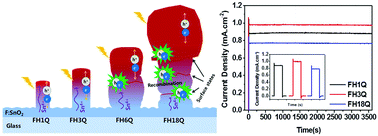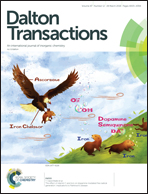Insights into the enhanced photoelectrochemical performance of hydrothermally controlled hematite nanostructures for proficient solar water oxidation†
Abstract
In this paper, we focus on the controlled growth mechanism of α-Fe2O3 nanostructures via the hydrothermal method. The field emission scanning electron microscopy (FESEM) results reveal that at a lower hydrothermal time, the initial nucleation involves the formation of short and thin β-FeOOH nanorods. The subsequent increase in the hydrothermal time leads β-FeOOH to form thicker and longer nanorods. However, high-temperature quenching (HTQ) at 800 °C for 10 min causes the conversion of akaganeite to the hematite phase and activation of hematite by Sn4+ diffusion from a FTO substrate. Sn4+ diffusion from the FTO substrate to the hematite nanostructure was elaborated by X-ray photoelectron spectroscopy (XPS). An α-Fe2O3 nanorod photoanode prepared by a hydrothermal reaction for 3 h and HTQ exhibits the highest photocurrent density of 1.04 mA cm−2. The excellent photoelectrochemical performance could be ascribed to the synergistic effect of the optimum growth of α-Fe2O3 nanorod arrays and Sn4+ diffusion. Intensity modulated photovoltage spectroscopy (IMVS) studies revealed that the α-Fe2O3 photoanodes prepared at 3 h and HTQ exhibited a long electron lifetime (132.69 ms), and contribute to the enhanced PEC performance. The results confirmed that the controlled growth of the β-FeOOH nanorods, as well as Sn4+ diffusion, played a key role in charge transfer during the photoelectrochemical application. The charge transfer mechanisms in α-Fe2O3 nanostructure photoanodes prepared at different hydrothermal times and high-temperature quenching are also investigated.



 Please wait while we load your content...
Please wait while we load your content...